What Is in Henry 8ths Crouch in Painting With He and Family
History in paintings. Male monarch Henry Eight and his vi wives
Divorced, beheaded, died, divorced, beheaded, survived… This is the mnemonic device for English language schoolchildren to remember the fates of 6 wives of King Henry VII. The history of the monarch, who inverse the religion of an unabridged country to go an heir, is well known, because it inspired multiple generations of writers, composers and filmmakers. In movies, the images of the queens were embodied past such stars every bit Charlotte Rampling, Helena Bonham Carter, Claire Foy, Natalie Portman, Natalie Dormer and Emily Blunt. Selecting their performers, the directors focused on their talent, not much on their resemblance. Let'due south see how these legendary women really looked.

Catherine of Aragon
Catherine of Aragon was the youngest daughter of Ferdinand of Aragon and Isabella of Castile. She was named Catalina (or Catherine, in the English manner) in honour of her maternal nifty-grandmother. She arrived in England in 1501 at the age of 15 to marry Arthur, Prince of Wales, just merely a few months later on the hymeneals, he passed away. In 1509, the Infanta became the wife of Arthur's younger brother Henry VIII. They had v children, of whom merely Princess Mary survived, who later became Queen Mary I of England. Catherine died in 1536, later she refused to recognize her marriage annulled in favour of the Rex's marriage to Anne Boleyn in 1533.
-
Maria Doyle Kennedy every bit Catherine of Aragon in The Tudors series
-
Charlotte Hope as Catherine of Aragon in the Spanish Princess mini-series
The National Portrait Gallery in London houses a portrait of the Queen, which was painted by an unknown artist in nearly 1520. Historians identified the model relatively recently, in 2013, and this film was exhibited along with a portrait of Henry Eight, stored in the same gallery. Although initially these panels did non brand a match, they accept a comparable appointment of creation, scale and a similar green damask background. Probably, these were examples of portraits of the king and queen, painted in several versions, some of which were shown together.
-
Unknown artist, «King Henry Viii» (ca. 1520). National Portrait Gallery, London
-
Unknown artist, «Catherine of Aragon» (ca. 1520). National Portrait Gallery, London
The Catherine of Aragon, as the Magdalene past Michael Sittow, an Estonian artist, is also widely known. This work is stored in the Detroit Constitute of Arts and represents the Infanta with a golden vessel in her hands. Catherine was to marry the Male monarch of England, and it seems that the creative person wanted to emphasize her modesty and chastity in this way.

On the Net, you can find some other image of the same Sittow's authorship, belonging to the Museum of the History of Art in Vienna. For a long fourth dimension, it was considered a portrait of Catherine of Aragon, merely recently a more reliable assumption has been put frontward that this is an image of Maria Rose Tudor, sister of Henry 8.
Anne Boleyn
She conquered the heart of Henry VIII, divided the church and became the Queen in 1533, shortly before the divorce of Henry and Catherine of Aragon. Later that twelvemonth, their daughter, Princess Elizabeth (later Queen Elizabeth I), was born. Past 1536, Henry was tired of Anne and, nevertheless desperate for an heir, began to doubt the legality of his marriage. In the same yr, Boleyn was accused of adultery and incest and executed in the Tower of London.

Anne Boleyn performed (height to lesser, left to right) past Natalie Dormer, Claire Foy, Natalie Portman and Charlotte Rampling
After beheading the beauty queen, her images were destroyed. They deleted Anne from history and so eagerly that simply one damaged medallion with her lifetime portrait has survived to this day, which is stored in the British Museum.
Having ascended the throne, Elizabeth I revived the retentiveness of her mother. The portrait closest to the original is considered to exist the one at the National Portrait Gallery in London. This picture is probably an early on copy of an unreserved image. They described Anne Boleyn as a adult female with a long neck, large mouth and dark beautiful optics. To restore this work, the gallery organized a campaign to raise funds and public donations.
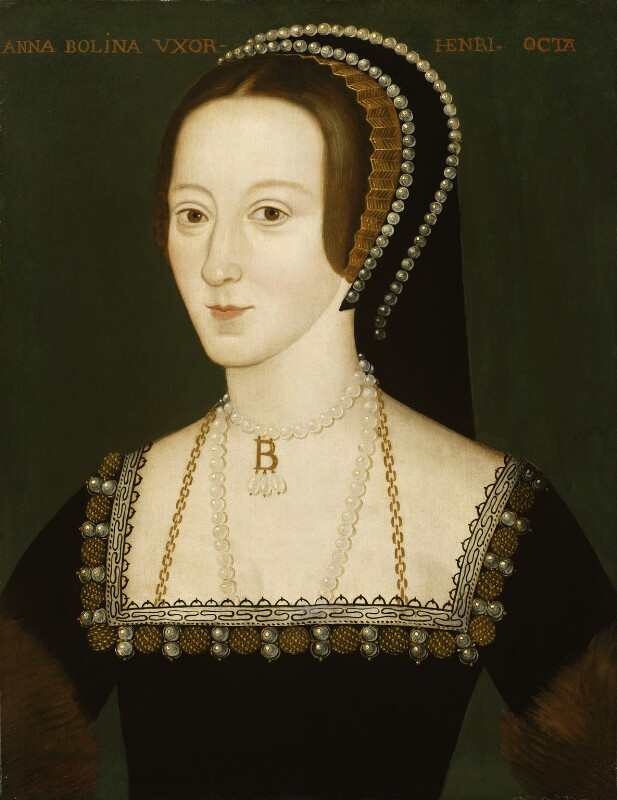
In 2015, a facial recognition program past researchers from California constitute a close resemblance between the woman depicted on the medallion from the British Museum and the paradigm stored in Bradford art galleries and museums. The picture from the Nidd Hall depicts a lady with jewels, who was considered Anne Boleyn for a long time. However, scientists did not come to a consensus about her personality. Some of them believe that this is the successor to Boleyn, Jane Seymour, the tertiary married woman of the King Henry.
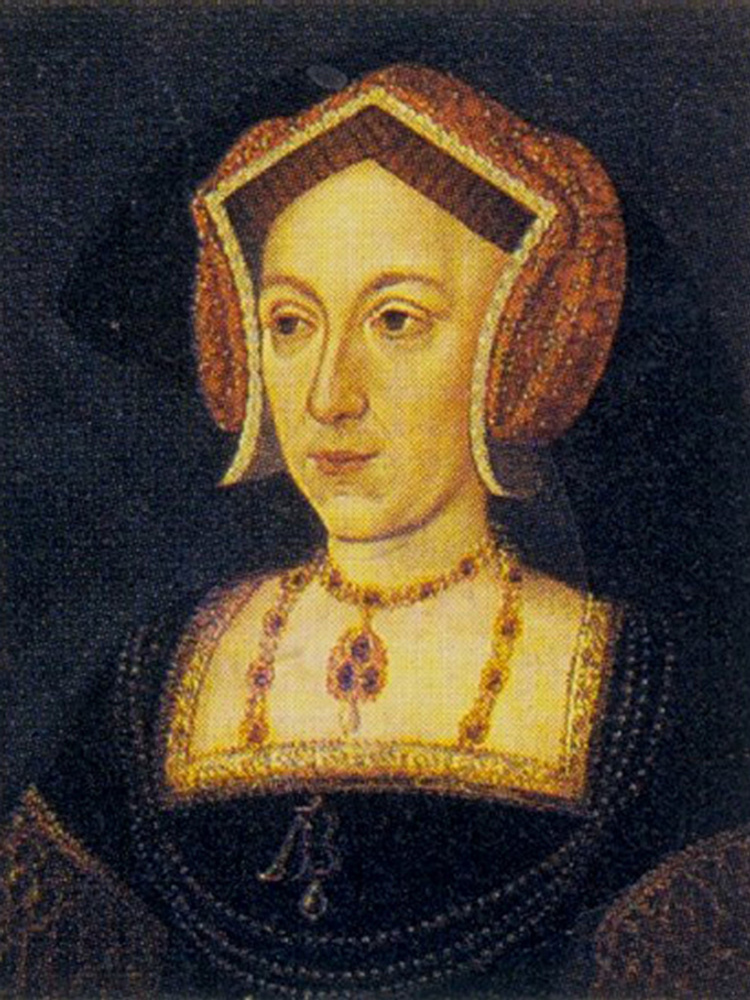
Alleged portrait of Anne Boleyn from Nidd Hall. Source: The Independent
Jane Seymour
Jane Seymour was born in Wolfhall, in the south of England, about 1509. She was the sister of Edward Seymour, subsequently Knuckles of Somerset, and Thomas Seymour, Lord Loftier Admiral. Henry Viii notive the girl when she was a maid of honor showtime of Catherine of Aragon, and then of Anne Boleyn. Jane married the king in May 1536, less than 2 weeks after the Anne's execution, and in Oct 1537 she fulfilled Henry'due south most hush-hush desire — she gave nativity to their son, who afterward became king Edward Vi. 12 days afterwards the birth of the boy, Jane died of a fever and was sincerely mourned by her hubby, who ordered to bury him next to her in Windsor.
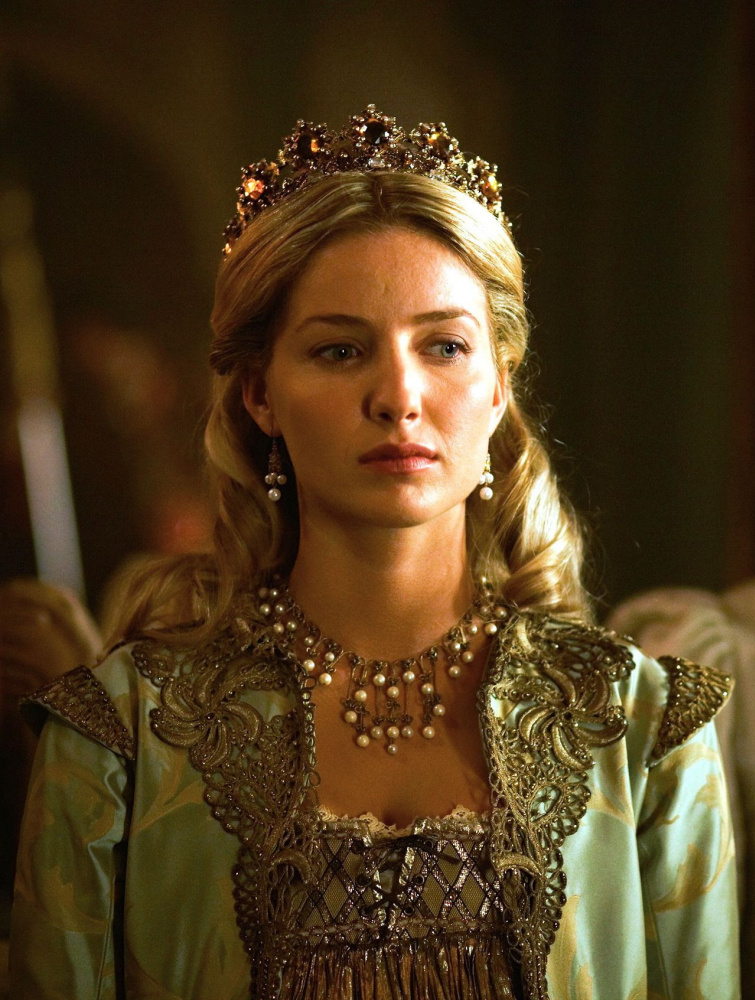
Annabelle Wallis as Jane Seymour in The Tudors series
The portrait of Hans Holbein the Younger, which is kept at the Vienna Museum of the History of Fine art, depicts no trace of this human drama. The painting captivates with brilliantly painted jewellery, pearls and expensive fabrics, which testify to the loftier rank of the model. She herself is cold and motionless, keeps the viewer at a distance, turning away from him. Obviously, Holbein created this image on the order of the King within the interval between the wedding and the early death of Jane (nearly likely the artist painted his like portrait, which has non survived to this day).
The Queen's paradigm is based on a chalk cartoon from the British Purple Collection. A trimmed copy of the portrait with small changes to the costume and jewellery is a part of the Mauritshuis gallery in The Hague. Despite the fact that the Holbein's workshop made several versions of the picture, the virtuosity and mastery of this duplicate suggests that it belongs to the castor of Holbein himself.
-
Hans Holbein the Younger, «Portrait of Jane Seymour» (ca. 1536). Museum of Art History, Vienna
-
Hans Holbein the Younger, «Portrait of Jane Seymour» (ca. 1536). Royal Gallery of Mauritshuis, The Hague
In all these portraits, Seymour wears the "Tudor bonnet" or gable, different her predecessor Anne Boleyn, who preferred a more modernistic arcelet — a lightweight "French hood" in the shape of a eye or horseshoe.
Hans Holbein the Younger, the most famous representative of the glorious association of artists, was the court painter of King Henry 8.
Anne of Cleves
After the death of Jane, the rex over again became to search for a new wife (at that time, i son was not still a firm guarantee of succession to the throne). Nevertheless, in Europe, his reputation every bit a husband was tarnished, and he was refused one past one. The advisor Thomas Cromwell convinced the monarch of the need for an alliance with the Protestants and the advisability of marrying the daughter of Duke Johann III of Cleves. Hans Holbein was sent to his court with an social club to pigment a portrait of the bride. Henry saw it and was delighted. However, having met the girl in reality, the fat, sick 48-year-erstwhile king found that she looked similar "a hefty Flemish mare", "she wasn't sweet and smelled bad", and said that this prevented him from fulfilling his conjugal duty.
-
Joss Rock equally Anne of Cleves in The Tudors serial
-
Hans Holbein the Younger, «Portrait of Anne of Cleves» (1539). Louvre Museum, Paris
Their divorce followed 6 months afterward the wedding. Since Anne was resigned to this, she was granted several estates, considerable content and the unofficial title of "the dearest sister of the King". The failed wife enjoyed freedom unprecedented for women of that era, because she did non depend on anyone except Henry, with whom she maintained warm friendly relations. She even refused to remarry, although she was given the privilege of choosing any spouse. Anne of Cleves was invited to the monarch'southward matrimony with his final chosen ane Katharina Parr, as a witness.
The notorious portrait past Holbein's castor is now stored in the Paris Louvre. The German Princess is depicted in finely balanced regal colors — rich red and dear-gold against a green groundwork. A close examination reveals that the artist did not flatter Anne of Cleves. Emphasizing her jewellery and clothes, he bluntly stated that he showed the model in the best possible way. She had an attractive confront, but dull optics, Holbein sought a remainder between honesty and decency.
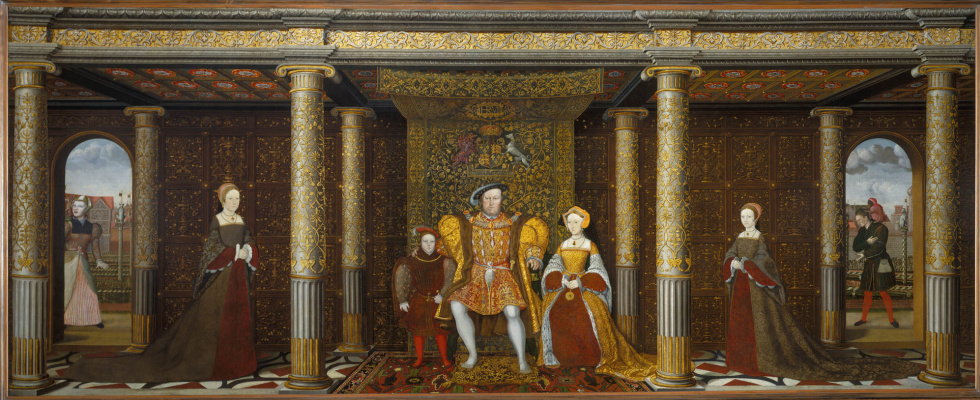
Historian David Starkey argues that there is no existent evidence that Holbein's portrait influenced Henry's decision to marry Anne of Cleves. According to the expert, the king listened to the convictions of influential courtiers, and this explains the fact that the artist was not punished for monstrous thwarting.
Catherine Howard
Catherine Howard came from a very noble family and was a maid of honour of Anne of Cleves. By September 1539, she had attracted the King's attention. They married on 28 July 1540. Even so, Catherine only was the Queen of England for 16 months; in November 1541, she became known to have cheated on Henry, and in Feb 1542 she was beheaded in front of a curious crowd.
-
Emily Blunt as Catherine Howard in the Henry Viii motion picture
-
Hans Holbein the Younger, «Portrait of a Lady, possibly Catherine Howard» (ca. 1540). Royal Collection, Windsor
There is no documentary show that the portrait of Catherine was painted during her life. However, historians exercise not exclude that this could be done during her short stay on the throne from July 1540 to November 1541 (Holbein managed to portray Jane Seymour, who reigned just as briefly). The British Royal Collection houses a medallion by the same Holbein, dated 1540. The already mentioned David Starkey identified the model equally the queen on the grounds that she wore jewellery that belonged to her predecessors — the aforementioned necklace with ruby, emerald and pearls can be seen in the portrait of Jane Seymour. However, it is known that Queen Jane presented her jewellery to her maids of honour, i of which, Mary Montegle, could be depicted on the medallion.
Catherine Parr
The last wife of Henry 8 was unique. At the time of the marriage with the king, she had already been a widow twice; she had no regal or courtroom background; she was smart enough and insightful to stay on the throne, despite the court plots and attempts to eliminate her. In 1545, Catherine Parr published her work "Prayers or Meditations", which made her not only the first English language Queen to publish prose, but also the outset adult female to do so in the 16th century.
The iconography of Catherine Parr is of detail interest. It is ironic that only v confirmed images have survived to this day, although she was the master patron of portrait painters in Tudor England. Thus, she ordered the kickoff full-length portraits of her stepdaughters Elizabeth and Mary, where she flatly wanted to emphasize their status as the heirs to the English language crown, and more a dozen of her ain images. Now we tin can imagine the final wife of Henry after the miniature from Sudley Castle and ii portraits from the National Portrait Gallery. Some other ane is kept in the Lambeth Palace and represents the young Catherine in the 1530s, and the fifth is a copy of Hans Eworth's painting from a private drove, it shows the queen at the end of her life.
Henry Eight passed away on 28 January 1547. Just four months afterward, Catherine Parr got married for the 4th time to Thomas Seymour, the brother of the Rex's third married woman. She died on v September 1548 from a fever, giving nativity to her only daughter Mary.
Source: https://arthive.com/publications/4400~Love_story_in_paintings_king_henry_viii_and_his_six_wives
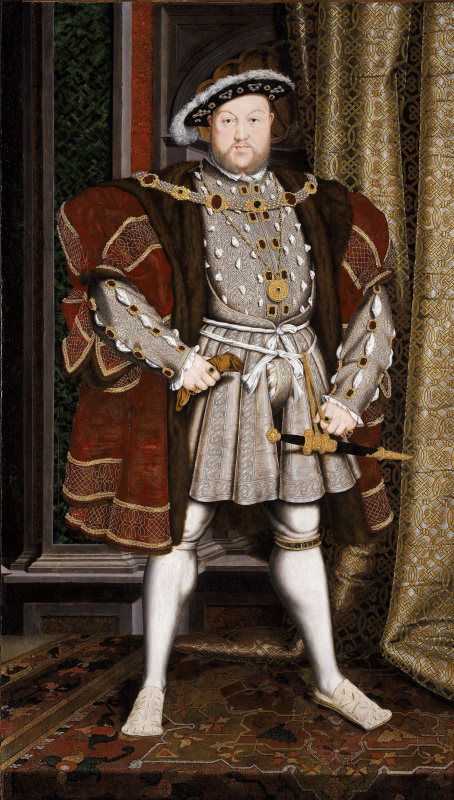


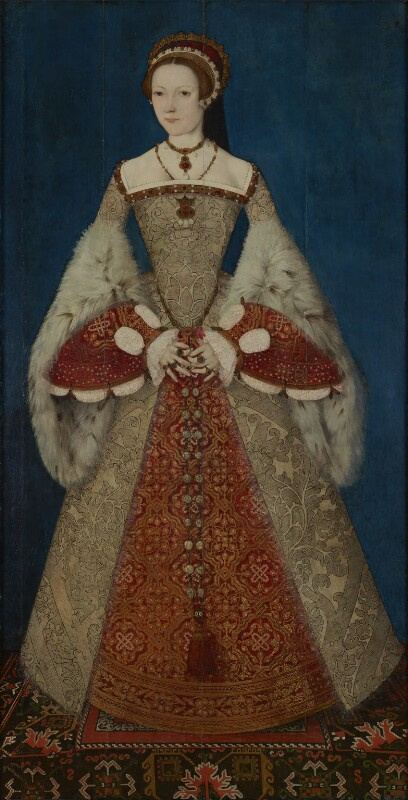
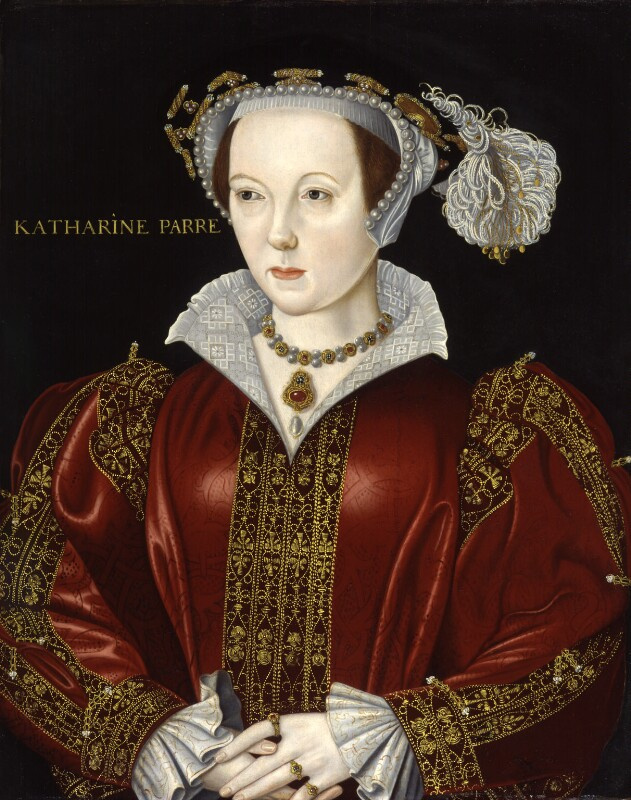
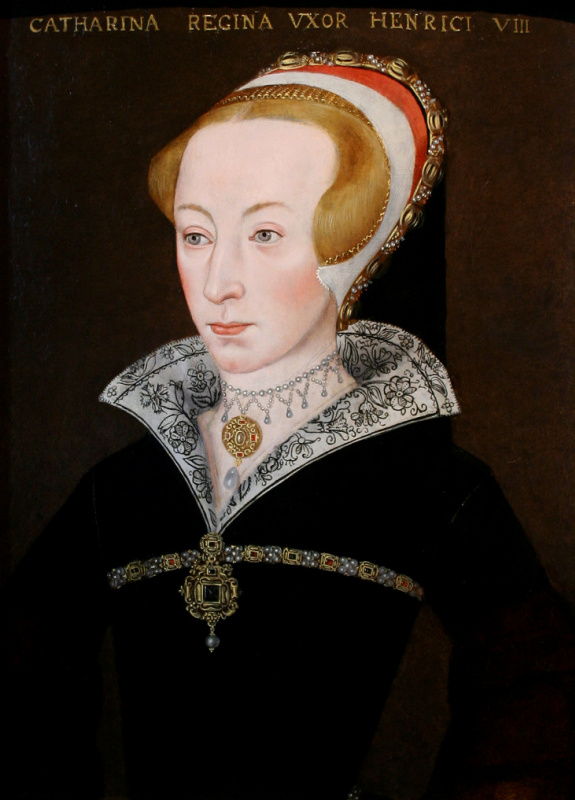
0 Response to "What Is in Henry 8ths Crouch in Painting With He and Family"
Post a Comment